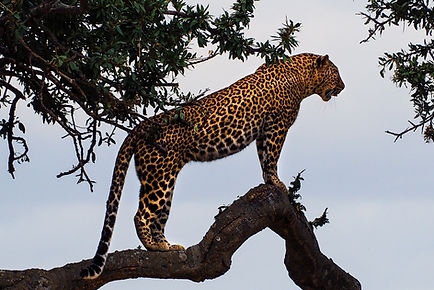

Leopard

The leopard is the pure definition of stealth and elusiveness in the animal kingdom. Many who hope to see a wild leopard will pass by one without even realizing it. The leopard's camouflage is remarkable.
Location
Leopards can be found in sub-Saharan Africa as well as the Middle East and Asia. They are solitary and only come together when it is time to mate. They are known to be territorial towards other leopards. Males dominate and patrol a certain amount of territory to ensure that no trespassing males invade. A male will also scent mark trees with urine to warn other passing leopards that a specific area is occupied.
These cats are apex predators. Relying on ambush techniques, leopards use their fur patterns to their advantage. Their spots are called rosettes. They assist the leopard in becoming almost invisible to unsuspecting prey. The random arrangement of rosettes causes the leopard to melt into its surroundings practically. The leopard's outline is broken up with the aid of their rosettes. They will prey on whatever they can physically overpower. This includes gazelle, birds, monkeys, warthogs, young cape buffalo, pythons, even porcupines. At full stride, they can hit swift speeds of up to 36 miles per hour. Their long tail acts as a rudder when making sharp turns while chasing prey that can turn on a dime.

Skillful climbing abilities are part of the leopard's reputation. They spend much of their time resting and feeding in trees. Their claws hook into tree bark to provide stability when walking on tree limbs. Powerful shoulder muscles give them the ability to haul themselves up tall trees with incredible speed. Strong neck muscles allow them to carry prey that is larger than themselves up against trees. On the African plains, it can be dangerous for leopards to eat their food on the ground. Lions or hyenas will chase a leopard off of its kill. Both can overpower the leopard and could kill or seriously injure one. One member of the big cat family that is not an actual threat to a leopard is the cheetah. The leopard is stronger than the cheetah. They possess more muscle power than cheetahs do.
Extra Attributes
Since they are primarily nocturnal hunters, they have astounding night vision and hearing. Their ears swivel like satellites to pick up faint sounds of prey in the night or listen for approaching enemies.
Size
Male and female leopards differ in size. Males can weigh up to 160 pounds, while females weigh around 130 pounds. In Mumbai, India, leopards can be seen traveling through urban areas by night and even prey on domestic animals. Farmers do their best to protect their livestock by using dogs which can also be preyed upon by leopards.
Threats And Conservation
Modern threats against leopards include illegal poaching, trophy hunting, and habitat loss. In addition, farmers clearing land for crops and livestock end up pushing leopards out of their habitat, increasing the chances of man and leopard conflict. Finally, leopards passing through the human territory, at one time the cat's home, can spark panic and result in the cat's death. Thankfully, conservation efforts, public education, and awareness of these animals give them a fighting chance at survival. It may be difficult to spot a leopard in the wild, but once seen, it will always be a mesmerizing moment in time for anyone.